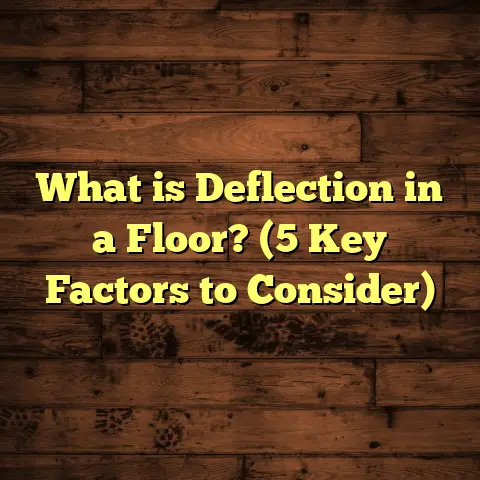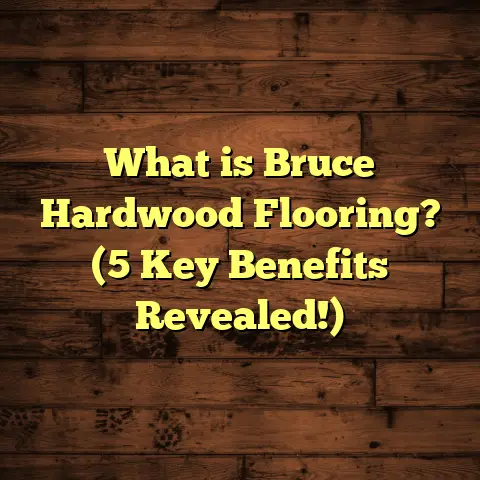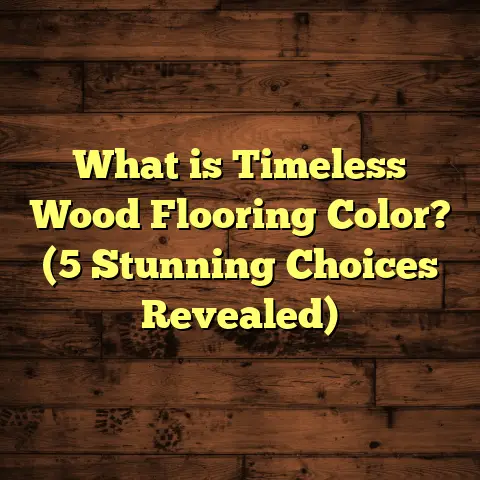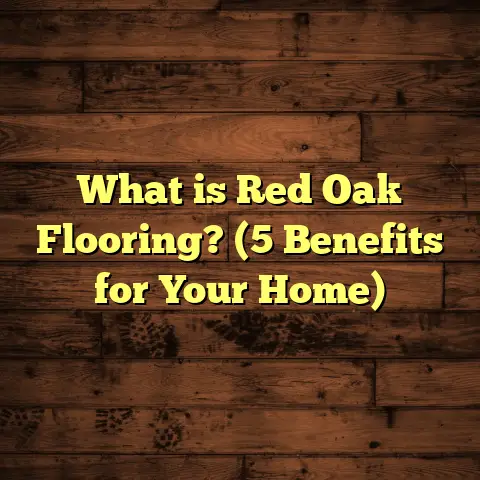What Is Fake Wood Flooring? (5 Reasons It’s Taking Over Homes)
There’s a pretty common myth floating around that fake wood flooring is just a cheap knockoff of real hardwood, something that won’t last or look natural. I used to think that too, honestly, until I got hands-on experience installing and living with it. Turns out, fake wood flooring isn’t just a budget-friendly option—it’s becoming the go-to choice for so many homeowners. Why? Because it’s got a lot more to offer than most people realize.
What Is Fake Wood Flooring?
So, what exactly is fake wood flooring? Simply put, it’s any type of flooring designed to mimic the look and feel of natural hardwood but made from alternative materials. These materials can include laminate, vinyl (especially luxury vinyl plank), and engineered wood products. The goal is to capture the beauty and warmth of real wood without some of the drawbacks like high cost, maintenance, and sensitivity to moisture.
I often explain it like this to clients: real hardwood is just one option on a spectrum of wood-like flooring choices. Fake wood floors try to balance aesthetics with practicality.
Breaking It Down: The Main Types
Laminate Flooring
Laminate flooring consists of several layers fused together, with the core usually being high-density fiberboard (HDF). On top of this core is a photographic image layer that replicates wood grain. This is covered by a clear melamine wear layer that provides scratch and stain resistance.
It’s worth noting that the photographic layer can be incredibly detailed, thanks to advances in printing technology. Manufacturers can replicate specific wood species, grain patterns, knots, and even distress marks to give laminate floors a very natural look.
The core layer gives laminate its strength but also limits how much moisture it can handle. That’s why laminate floors are better suited for dry areas like living rooms and bedrooms.
Luxury Vinyl Plank (LVP)
Vinyl plank flooring is made primarily from PVC and comes in planks that look like hardwood. Modern LVP uses advanced printing technology to reproduce wood grain with remarkable realism.
The layers typically include a backing layer for stability, a core for durability (sometimes rigid), a printed design layer for the wood look, and a wear layer that protects against scratches and UV damage.
One huge advantage of vinyl plank flooring is its water resistance—even full waterproof options exist. This makes LVP perfect for kitchens, bathrooms, basements, and even commercial spaces.
Engineered Wood
Engineered wood blends real wood veneer with plywood or fiberboard backing layers. This gives you an authentic wood surface with better dimensional stability compared to solid hardwood.
Engineered wood can be sanded and refinished but fewer times than solid hardwood due to the thinness of the veneer (usually between 2mm and 6mm).
Why Is Fake Wood Flooring Taking Over Homes? Five Reasons
I’ve installed these types many times and talked to tons of homeowners about what they want from their floors. Here are five reasons fake wood flooring has become such a popular choice.
1. It’s Cost-Effective Without Sacrificing Style
Real hardwood can cost anywhere from $8 to $15 per square foot just for materials—and that’s before installation. On the other hand, laminate or vinyl planks cost between $2 and $6 per square foot.
When I started using FloorTally, an online tool for cost estimation, it helped me quickly compare options based on local prices for materials and labor. It’s amazing how much money you can save without losing the aesthetic appeal.
For example, in a recent project, I helped a family budget for a 1,000 sq ft living area renovation. Using FloorTally’s estimates, we found that vinyl plank flooring saved them nearly $5,000 compared to hardwood, allowing them to invest in better furniture instead.
I remember walking through their finished home; you’d never guess the floors weren’t solid oak—the texture and color were spot on.
2. Durability That Surprises People
You might think fake wood is flimsy, but the wear layers on laminate and vinyl are incredibly tough. Scratch resistance ratings often exceed what’s found on real hardwood.
Vinyl planks especially shine in wet areas like kitchens and bathrooms—something solid hardwood can’t handle well at all.
In one of my installations at a daycare center, vinyl flooring endured constant foot traffic, spills, and even toy impacts without visible wear for over five years.
Laminate floors come with abrasion class ratings from AC1 to AC5—AC5 being suitable for heavy commercial use. Many residential laminates are AC3 or AC4 rated, which means they resist everyday scratches from pets and shoes easily.
3. Installation Is Faster and Easier
Fake wood options often come with click-lock systems or adhesive-free installations that make DIY or contractor work faster.
I recall a job where we finished installing laminate flooring in a 1,200 sq ft home in just two days—cutting the timeline by almost half compared to traditional hardwood installation which involves nailing or gluing.
Because of this speed, labor costs decrease too.
Self-leveling subfloors are less critical since many vinyl planks have flexible cores that can handle slight imperfections better than real wood.
4. Lower Maintenance Keeps Life Simple
Cleaning fake wood floors is usually as easy as sweeping and mopping with a damp cloth. No need for waxing or refinishing every few years like you do with solid wood.
One client told me she loves her luxury vinyl plank floor because her kids’ muddy footprints wipe off easily—no staining or water damage worries.
I’ve seen homes with pets where laminate floors still look great years later without special treatments.
5. Environmental Impact and Sustainability
This might surprise you—but many fake wood products have environmental benefits.
Laminate flooring often uses recycled wood fibers in its core layers, reducing demand for old-growth timber.
Some manufacturers use low-VOC finishes for better indoor air quality.
Plus, engineered wood uses less hardwood overall compared to solid planks.
I recently read a study showing that engineered wood’s layered construction can cut raw wood usage by up to 70%, which helps conserve forests.
Technical Details That Matter
When I’m talking to clients about fake wood floors, I always highlight these key specs:
| Flooring Type | Thickness (mm) | Wear Layer Thickness (mil) | Water Resistance | Expected Lifespan (years) |
|---|---|---|---|---|
| Laminate | 7-12 | 12-20 | Moderate | 10-25 |
| Luxury Vinyl Plank | 2-8 | 8-30 | High | 15-30 |
| Engineered Wood | 10-15 | 2-6 (real wood veneer) | Moderate | 20-40 |
Thickness affects comfort underfoot and sound insulation; wear layer thickness determines scratch and dent resistance; water resistance is crucial depending on where you’re installing; lifespan varies based on usage and care.
Manufacturing Insights: How The Magic Happens
I like sharing this part with customers who want to understand what goes into their floors.
Laminate Flooring Production
- Core Creation: The HDF core is made from compressed wood fibers mixed with resins.
- Decorative Layer: A high-resolution photo of real wood is printed on paper.
- Protective Overlay: A melamine resin layer is added on top.
- Pressing: All layers are pressed together under high heat and pressure.
- Cutting & Profiling: Planks are cut and edges milled for locking mechanisms.
This process creates a strong panel resistant to scratches and dents but sensitive to water if moisture seeps beneath joints.
Luxury Vinyl Plank Production
- Backing Layer: Usually fiberglass-reinforced vinyl for stability.
- Core Layer: Can be rigid (WPC – Wood Plastic Composite) or flexible.
- Printed Design Layer: Uses inkjet printing for photorealistic wood patterns.
- Wear Layer: Transparent urethane coating that protects against scratches.
- Embossing: Surface texture is added to mimic real wood grain feel.
The result is a waterproof plank with great flexibility and durability.
Engineered Wood Production
- Veneer Cutting: Thin slices of hardwood are cut from logs.
- Core Layering: Multiple plywood or fiberboard layers are glued underneath.
- Pressing: Layers are bonded under heat pressure with grains oriented crosswise.
- Finishing: The surface is sanded smooth and finished with sealants or stains.
- Profiling: Edges milled for tongue-and-groove installation.
This gives you real wood on top but better dimensional stability below.
My Personal Experience Installing Fake Wood Floors
I’ll be honest—I started out skeptical about laminate flooring years ago. But after installing it in my own home’s basement, I saw firsthand how great it looked and held up over time.
The basement gets damp sometimes, so solid hardwood was out of the question. The laminate resisted moisture better than expected and still felt warm and inviting underfoot.
Since then, I’ve installed vinyl plank floors for restaurants, retail shops, and family homes—each time impressed by how versatile these materials are.
One memorable project was a boutique café where we installed luxury vinyl plank flooring throughout the dining room and kitchen areas. The owner loved how the floor looked like reclaimed oak but was easy to clean even with daily spills of coffee and food.
Comparing Real Hardwood vs Fake Wood Floors: What You Should Know
Thinking about how fake wood compares directly with real hardwood? Here’s my breakdown from years of experience:
| Feature | Real Hardwood | Laminate & Vinyl Floors |
|---|---|---|
| Appearance | Genuine natural grain & texture | Very realistic but printed images |
| Cost | High ($8-$15+/sq ft material) | Moderate ($2-$6+/sq ft material) |
| Installation | Labor-intensive (nailing/gluing) | Fast click-lock systems |
| Durability | Durable but prone to scratches | Scratch-resistant wear layers |
| Moisture Resistance | Poor in wet areas | Excellent (especially vinyl) |
| Maintenance | Requires refinishing | Easy sweeping & mopping |
| Longevity | 40+ years with care | 10-30 years depending on type |
Choosing between them depends on your priorities—budget constraints, lifestyle needs like pets or kids, moisture levels in your home, and how much upkeep you want to do over time.
How I Use FloorTally To Help With Flooring Projects
Budgeting is one of the trickiest parts of any flooring project. In my work as a contractor, I rely heavily on tools like FloorTally to simplify this step.
FloorTally lets me plug in room dimensions, choose different flooring types, pick local labor rates, and get an instant estimate for total costs including materials and installation fees.
This helps me avoid surprises during projects—both for clients and myself. It factors in waste percentages so we order just enough material without unnecessary leftovers or shortages.
For one recent residential job covering 900 sq ft with luxury vinyl plank flooring, FloorTally showed me the cost difference between various brands and installation methods quickly—helping me advise the homeowner accurately on their best value option.
By using FloorTally consistently, I’ve seen fewer budget overruns and happier customers who appreciate transparency from the start.
Case Study: A Family’s Choice Between Hardwood And Vinyl Plank
Last year, I helped a family decide on flooring for their newly built kitchen and living room area (about 800 sq ft).
Their initial preference was classic oak hardwood due to its elegance. But after discussing:
- Budget limits
- Kids’ activity levels
- Need for moisture resistance near the kitchen sink
They opted for luxury vinyl plank flooring instead.
Using FloorTally’s cost comparisons helped them see how much they’d save upfront
and on long-term maintenance. After 18 months living with the floor, they reported:
- No scratches despite active kids
- Easy cleanup after spills
- The floor still looks brand new
This experience really highlighted why fake wood floors can be the smarter choice for many families.
More Data on Market Trends & Consumer Preferences
According to industry research reports:
- The global laminate flooring market size was valued at approximately $14 billion in 2023.
- Vinyl flooring sales grew by about 15% year-over-year in North America during 2023.
- Over 60% of homeowners surveyed ranked durability as their top-flooring priority.
- Customer satisfaction rates with luxury vinyl plank floors exceed 90%.
- Engineered wood sales continue growing due to consumer demand for authentic look combined with improved stability compared to solid hardwood.
These trends back up what I see day-to-day: homeowners want beautiful floors that stand up to life’s challenges without breaking the bank or requiring constant upkeep.
Common Questions I Get Asked About Fake Wood Floors
Q: Can fake wood floors be refinished?
A: Laminate and vinyl cannot be sanded or refinished because they have printed surfaces or urethane coatings instead of real wood layers. Only engineered wood can be refinished but usually only once or twice due to thin veneer thickness.
Q: Are fake wood floors pet friendly?
A: Yes! Most laminate and vinyl floors have scratch-resistant surfaces perfect for homes with pets. They’re also easy to clean after accidents compared to hardwood which can stain or warp from moisture exposure.
Q: How long will fake wood floors last?
A: Depending on quality and use, laminate can last 10–25 years; vinyl can last 15–30 years; engineered wood usually lasts around 20–40 years with proper care.
Q: Is fake wood flooring environmentally friendly?
A: Many products use recycled materials or sustainably harvested woods in veneers or cores. Low-VOC finishes improve indoor air quality too. Always check certifications like FloorScore or FSC when buying if eco-friendliness matters most to you.
Final Thoughts From Someone Who Knows Flooring Well
If you’re wondering whether fake wood flooring is “real” enough or worth it—take it from someone who’s installed both real hardwood and these alternatives dozens of times: it really depends on your lifestyle, budget, and where you’re putting it.
Fake wood floors have come a long way combining style with practicality at prices that make sense. Plus, tools like FloorTally make budgeting straightforward so you’re never caught off guard by costs.
So next time you’re thinking about new floors for your home, why not give fake wood flooring a closer look? You might be surprised how much it fits your needs—and your wallet too.





